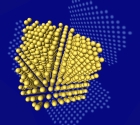From a purely chemical point of view, nanoparticles have different properties than their larger counterparts: they have a large surface area relative to their small mass and contain a small number of atoms. This combination may produce quantum effects that can change the properties of the materials. For example, ceramic materials made of nanoparticles may suddenly become bent, or a gold nugget is painted gold while silver nanoparticles become reddish.

The chemical and physical properties of nanoparticles are determined according to their three-dimensional configuration, their atomic structure and especially according to their surface composition. In a study conducted by German researcher Marta Rossell from ETH University, the three-dimensional structure of individual nanoparticles at their atomic level has now been determined. The innovative method could help improve our understanding of the properties of nanoparticles, including their activity and toxicity.
for their research using an electron microscope, which was recently published in the prestigious scientific journal Nature, The researchers prepared silver nanoparticles inside a substrate of aluminum. The substrate facilitates coating of the nanoparticles under the electron beam in different flow directions while protecting them from damage that may arise from the intensity of the beam. The basic prerequisite for the research was the use of a special electron microscope with a resolution of less than fifty picometers, when the diameter of a single atom is approximately one hundred picometers.
In order to further protect the specimen, the special electron microscope, of which there are only a few in the entire world, was operated at a lower acceleration voltage level to produce images with atomic resolution.
On the basis of the images obtained, researcher Sandra Van Aert from the University of Antwerp produced models that further sharpen the images and which make it possible to quantify them: the sharpened images made it possible to actually count the individual silver atoms along the different directions of the charges.
In the next step, these data provided information for the construction of the atomic model of the nanoparticle using a suitable mathematical algorithm. Only two images from the multitude of images produced were good enough to build the three-dimensional configuration of the nanoparticle, which consists of 784 atoms. "Until today, it was only possible to distinguish the contours of the nanoparticles, and that only by combining many images obtained from different charges," explains the researcher.
"Our method could lead to the development of new applications, such as the characterization of nanoparticles in which other substances are embedded in varying amounts," notes one of the researchers. For example, the method could be used in the future to determine what is the most active configuration of atoms obtained by the surface of the nanoparticles, and whether they have toxicity or catalytic ability.
